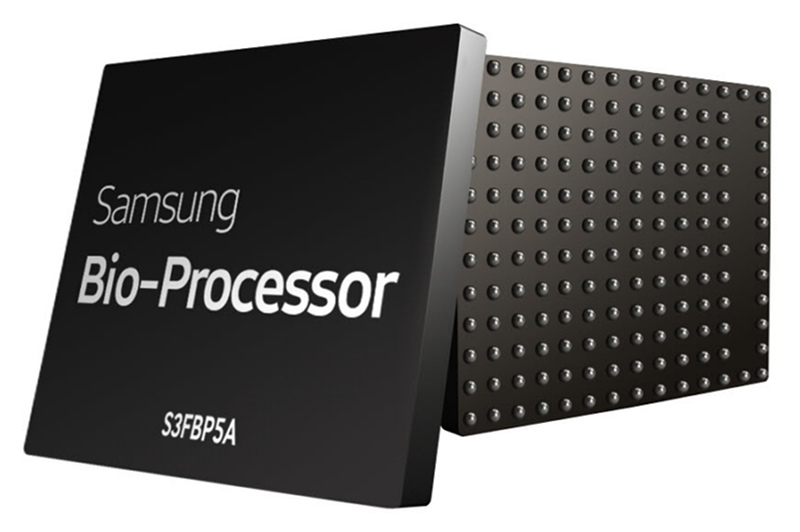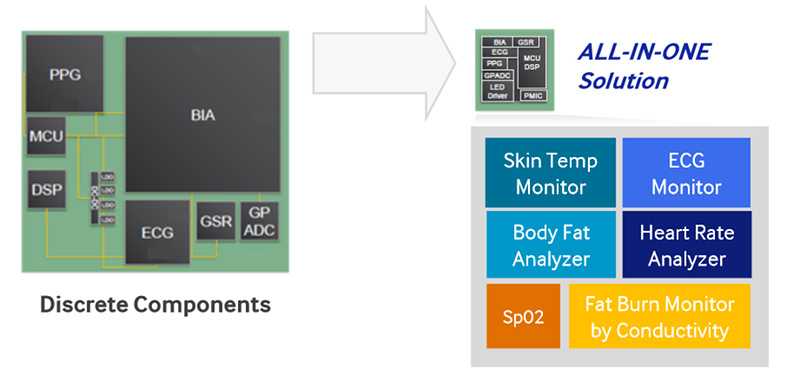Samsung bio-processor
The Internet of Things segment, related to information about the state of the organism and user activity, is today one of the most dynamically developing. This can be explained by several factors, including health care, the capabilities of wearable electronics devices that are understandable to end users, in some cases, a relatively low price and, of course, fashion.
On the one hand, it is often possible to use sensors already present in many mobile devices for such tasks. You only need to add the appropriate software to process the signals coming from them. However, this approach has undesirable consequences for such an important parameter as the battery life of the device. It would be a logical solution to install specialized processors that can autonomously perform the tasks of primary data storage and processing. As an example, we can recall Apple's use of the NXP coprocessor from the iPhone 5S for the background service of motion sensors.

At the very end of last year, Samsung published a press release about the start of production of a new type of chip called the “smart bioprocessor”.
It focuses on the segment of wearable electronics, designed to monitor human condition. Thanks to the integration of digital and analog inputs, a signal processing processor, a microcontroller, a power controller and flash memory into a single SiP chip, it was possible to significantly reduce the required dimensions.

The first model, code-named S3FBP5A, has the Cortex M4 core, is equipped with 256 KB of RAM and 512 KB of flash memory, and also has support for SPI and I2C interfaces. It is also important that the device supports security functions, including hardware data encryption, and the
device is capable of servicing five sensors, including skin temperature and bioelectric impedance. On their basis, it will be possible to obtain information such as heart rate and stress level.

To accelerate the development of devices based on the new chip, the company also offers several reference platforms. At the CES 2016 exhibition held in early January, the company showed a prototype device with a new processor, but no details were provided about it, including the possibility of appearing on sale. The model, called S-Patch, has a compact size, the ability to determine the heart rate and communicates with the smartphone via Bluetooth.

A little later, a photograph of an unknown device flashed in the news line, which could well turn out to be an external sensor with an integrated bioprocessor designed to work with smartphones and watches.
Mass production of products using the Samsung bioprocessor is expected in the first half of this year.
On the one hand, it is often possible to use sensors already present in many mobile devices for such tasks. You only need to add the appropriate software to process the signals coming from them. However, this approach has undesirable consequences for such an important parameter as the battery life of the device. It would be a logical solution to install specialized processors that can autonomously perform the tasks of primary data storage and processing. As an example, we can recall Apple's use of the NXP coprocessor from the iPhone 5S for the background service of motion sensors.

At the very end of last year, Samsung published a press release about the start of production of a new type of chip called the “smart bioprocessor”.
It focuses on the segment of wearable electronics, designed to monitor human condition. Thanks to the integration of digital and analog inputs, a signal processing processor, a microcontroller, a power controller and flash memory into a single SiP chip, it was possible to significantly reduce the required dimensions.

The first model, code-named S3FBP5A, has the Cortex M4 core, is equipped with 256 KB of RAM and 512 KB of flash memory, and also has support for SPI and I2C interfaces. It is also important that the device supports security functions, including hardware data encryption, and the
device is capable of servicing five sensors, including skin temperature and bioelectric impedance. On their basis, it will be possible to obtain information such as heart rate and stress level.

To accelerate the development of devices based on the new chip, the company also offers several reference platforms. At the CES 2016 exhibition held in early January, the company showed a prototype device with a new processor, but no details were provided about it, including the possibility of appearing on sale. The model, called S-Patch, has a compact size, the ability to determine the heart rate and communicates with the smartphone via Bluetooth.

A little later, a photograph of an unknown device flashed in the news line, which could well turn out to be an external sensor with an integrated bioprocessor designed to work with smartphones and watches.
Mass production of products using the Samsung bioprocessor is expected in the first half of this year.
